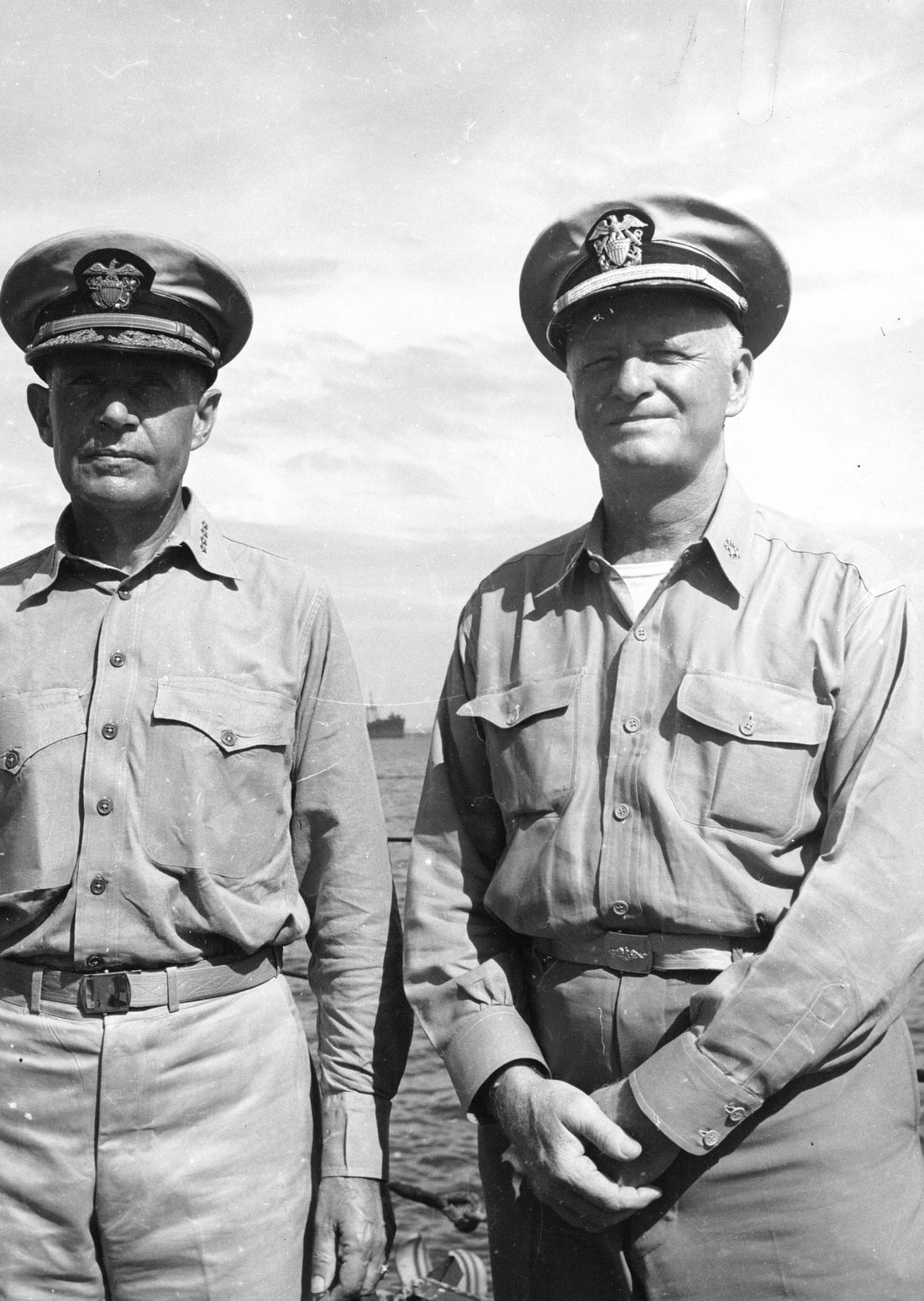
Calculated Risk and Caffeinated Guesswork: How Spruance, Nimitz, and a Whole Lot of Guts Saved the Pacific at Midway
In June of 1942, while most of the world was still reeling from the shock of Pearl Harbor just six months prior, the U.S. Navy quietly set the stage for one of the most decisive naval victories in history—the Battle of Midway. And it wasn’t won with brute strength or overwhelming firepower. It was won with nerve, intelligence, and a very specific kind of Navy leadership: the kind that favors sharp thinking over showboating, gut instinct over paralysis by analysis, and just enough black coffee to keep the war room sharp.
At the heart of this victory? Two men: Admiral Chester W. Nimitz and Admiral Raymond Spruance. One was the strategic mastermind, the other the calm hand on the wheel. Together, they executed a battle plan so bold it still leaves historians shaking their heads in admiration.
The Setup: Reading the Enemy’s Email
At Station HYPO, the Navy’s codebreaking team led by Commander Joseph Rochefort cracked enough of the Japanese Navy’s JN-25 code to detect a major operation in the works. The Japanese referred to their target as “AF.” Rochefort and his crew suspected it was Midway Atoll, but suspicion isn’t confirmation.
So they got clever. Midway sent a fake, unencrypted message claiming their water purification system was broken. Shortly after, Japanese intelligence picked it up and radioed that "AF was short on water." Boom. Confirmation. The trap was set.
Nimitz didn’t blink. He didn’t form a committee or ask for a second opinion. He acted.
Nimitz: Calm, Confident, Calculated
As Commander in Chief of the Pacific Fleet, Admiral Chester Nimitz was the man in charge of stopping Japan's momentum—and he did it by embracing a concept now famous in Navy circles: calculated risk. As he explained:
“The principle of calculated risk: avoiding exposure of our force without good prospect of inflicting greater damage on the enemy.”
Translation? Let’s roll out with fewer carriers, half the fuel, and a weather report we don’t trust—because if our timing’s right, we’ll hit them so hard they won’t know what happened until they’re scanning the horizon for smoke that used to be their fleet.
It wasn’t reckless. It was resolute. And when your margin for error is thinner than a carrier’s flight deck, that kind of steady leadership is everything.
Spruance: The Unexpected Hero
With Admiral Halsey sidelined due to illness, Nimitz needed someone to take command of Task Force 16. He turned to Rear Admiral Raymond Spruance—a cruiser guy, not an aviator. By conventional logic, it was like asking your ship’s engineer to fly the plane. But Nimitz trusted Spruance’s judgment, calm demeanor, and intellect—and he wasn’t wrong.
Spruance took over command of USS Enterprise (CV-6) and USS Hornet (CV-8) on the eve of battle. On June 4, 1942, he made one of the most critical calls of the war: launching a full strike on the Japanese carriers the moment they were spotted—without waiting for full confirmation or ideal positioning. His decision caught the enemy in the worst possible posture: decks full of fueled planes and bombs.
The result? Four Japanese carriers—Akagi, Kaga, Soryu, and Hiryu—went down in flames. Japan’s carrier fleet never recovered.
Spruance didn't brag. He didn't publish a memoir titled "How I Saved the Pacific." He handed command back to Halsey when he returned and moved on—quieter than a submarine at silent depth.
Yorktown: Battered but Back in the Fight
If this were a movie, you’d roll your eyes. Just weeks before Midway, the USS Yorktown (CV-5) was badly damaged at the Battle of the Coral Sea. A bomb tore through her decks, causing fires and structural damage so extensive, Navy engineers estimated it would take three months to repair her.
But three months wasn’t an option.
Nimitz ordered her into Pearl Harbor and told the yard workers: “You’ve got 72 hours. She fights at Midway.” And they made it happen. Working around the clock, using parts from other ships and ignoring anything non-essential, repair crews got her seaworthy in three days.
Yorktown limped into Midway bruised but ready, joining Enterprise and Hornet as the third U.S. carrier in the battle. Her air group helped sink Sōryū and Hiryū, and she absorbed hits from Japanese torpedoes before finally being abandoned. She didn’t survive the battle—but she made victory possible.
That’s the Navy. That’s Midway.
The Aviators Who Turned the Tide
The Douglas SBD Dauntless dive bombers were the unsung heroes of Midway. Nicknamed "Slow But Deadly," these aircraft delivered precision strikes that crippled the Japanese fleet. On the morning of June 4, 1942, Dauntless squadrons from Enterprise and Yorktown exploited a critical lapse in Japanese air cover. With enemy fighters drawn low to intercept torpedo bombers, the SBDs dove from 15,000 feet, releasing bombs that ignited catastrophic fires on Akagi, Kaga, and Sōryū. Later that day, they also fatally damaged Hiryū, ensuring all four Japanese carriers were lost.
The torpedo squadrons, flying obsolete and outdated TBD Devastators, faced harrowing odds. Torpedo Squadron 8 (VT-8) from Hornet launched without fighter escort, and all 15 aircraft were shot down without scoring a hit. Similar fates befell VT-6 from Enterprise and VT-3 from Yorktown. Of the 42 torpedo planes launched, only six returned. Their sacrifice, however, was not in vain. By drawing Japanese fighters to low altitudes, they cleared the skies for the Dauntless dive bombers to execute their devastating attacks.
Amidst this chaos, Lieutenant Commander John "Jimmy" Thach led six F4F Wildcat fighters from Yorktown's Fighting Squadron 3 (VF-3). Confronted by approximately 20 to 40 Japanese Mitsubishi A6M Zero fighters, Thach employed his innovative "Thach Weave" maneuver. This tactic allowed his outnumbered squadron to shoot down several enemy aircraft and protect the torpedo bombers. For his leadership and bravery, Thach was awarded his second Navy Cross.
We honor Thach’s legacy every day at Old Salt Coffee—with his F4F Wildcat launching from a carrier at Midway featured prominently on every bag of our Brown Shoe Blend Coffee. It's a tribute to his courage, ingenuity, and the naval aviators who kept fighting when the odds said they shouldn’t.
The Legacy: Why It Still Matters
The victory at the Battle of Midway was far more reaching than merely winning a single confrontation. The victory bought critical time and breathing room for the Allies to amass their forces and prosecute the Pacific War. The battle marked the end of Japanese expansion and offensive operations in WWII, permanently shifting the momentum of the war. From that point forward, Japan was on the defensive—fighting to hold ground, not seize it.
It validated the aircraft carrier as the new capital ship in naval warfare, relegating the venerable battleship to a supporting role. The battle also exposed the vulnerability of overreach, and proved that timely intelligence and decisive leadership are force
multipliers which can overcome even a numerically superior enemy.
Historians have recognized Midway not just as a tactical triumph, but as one of the most strategically decisive victories in all of military history. Why? Because it changed the course of an entire war in just 72 hours. It wasn’t just about sinking ships—it was about reshaping the Pacific balance of power.
Naval historian Craig L. Symonds ranks Midway alongside Salamis, Trafalgar, and Tsushima Strait—battles that didn't just decide wars, but redefined how wars were fought. And the U.S. Naval Institute calls it “the most decisive naval victory since Trafalgar, and perhaps the most strategically decisive victory since Salamis.”
Why? Because Midway didn’t just stop Japan—it started America’s long march to victory. The scales tipped, and they never tipped back.
Hoist a Mug to the Men of Midway
This June, as we remember the Sailors, aircrews, codebreakers, and commanders of Midway, let’s hoist a quiet mug in their honor—not out of nostalgia, but out of respect. Not because it’s romantic, but because it was real—messy, costly, and world-changing.
Whether you’re manning a desk or a destroyer, what mattered then still matters now: clarity under pressure, the courage to act, and the grit to see it through. Those were the ingredients at Midway.
No fancy tech. No over-the-top theatrics. Just the right people, doing the right thing, at the right time.
And if a strong cup of coffee helped a few of them get there—we’re proud to carry that torch.
Explore More
Hashtags:
#HoistAMug #BattleOfMidway #CalculatedRisk #ChesterNimitz #RaymondSpruance #WWIIHistory #NavalHeritage #VeteranOperated #OldSaltCoffee #MidwayAnniversary #PremiumCoffee #NavyPride #CoffeeThenWar


1 comment
A poor rendition of the history of The Battle of Midway. The Japanese did not have decks full of planes loaded with bombs and fuel. The planes had not been spotted when the first attack to place. They were below decks where they were in the process of being rearmed…Accuracy counts.
Fred Judson